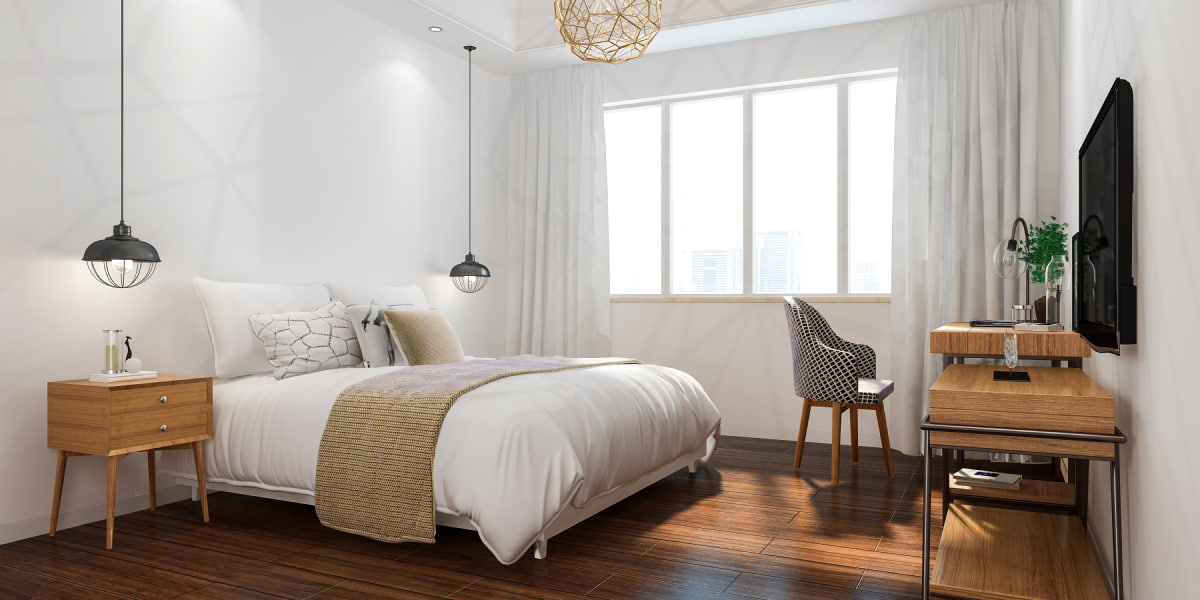Published on November 18th, 2022
Last updated on February 3rd, 2023
Guide On All Types & Styles Of Curtains For Any Room In Your House!
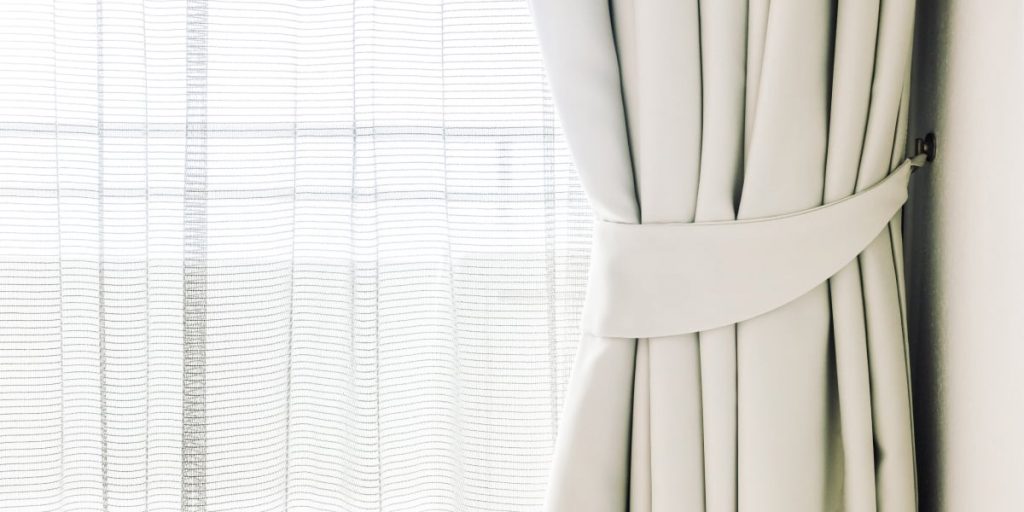
It is believed that the windows are the soul of the house. It is the eyes that see everything outside and inside. To complete the abstraction of eyes in the form of windows, you need to add…eyebrows? Yes! Your eyebrows in the house will be the curtains, perhaps even more critical. All because window each curtains types, like eyebrows, frame, and shape the unique design of a room.
As with different types of eyebrows, there are a variety of curtains to suit various homes and rooms. Curtains come in a variety of fabrics, including cotton, linen, silk, and velvet. They can be transparent or opaque, monochrome, or patterned. They can be made in various styles, from simple, classic, modern, and spectacular.
In this guide, we’ll look at all the different types and styles of window curtains so you can choose the perfect ones for your home. Let’s start transforming your home!
Quick List of Window Curtain Types
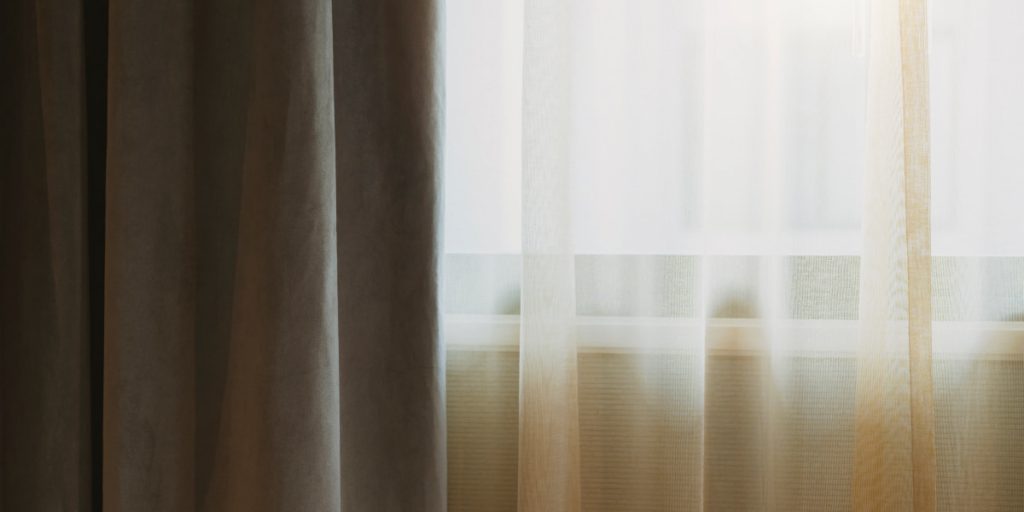
Millions of people around the world use curtains. Think about it, is there anyone among your family and friends who has never used curtains for windows? Surely you can not remember anyone, or it will be 1-2 people with 20.
The primary purpose of curtains is to cover up the light that passes through the windows. But they have another use – to decorate the room. Fortunately, you do not need to choose between functionality and style. There are many different types of curtains for the home that combine functionality and great aesthetics. Here are some drapery types:
- Panel Pair Curtains
- Single Panel Curtain
- Window Treatment Sets
- Valances
- Window Tiers
- Window Scarf
- Curtain Liners
- Sheer
- Semi-Opaque
- Blackout Curtains
- Rod Pocket Curtains
- Grommet and Eyelet Curtains
- Tab Top
- Hidden Tab Curtains
- Cotton
- Linen
- Velvet
- Silk
- Burlap
- Synthetic
- Sill
- Apron
- Floor
- Puddle
- Insulating
- Noise Reducing
- Outdoor Curtains
Now it is time to look closely at each window curtain type.
Buyers’ Guide: Types of Curtains
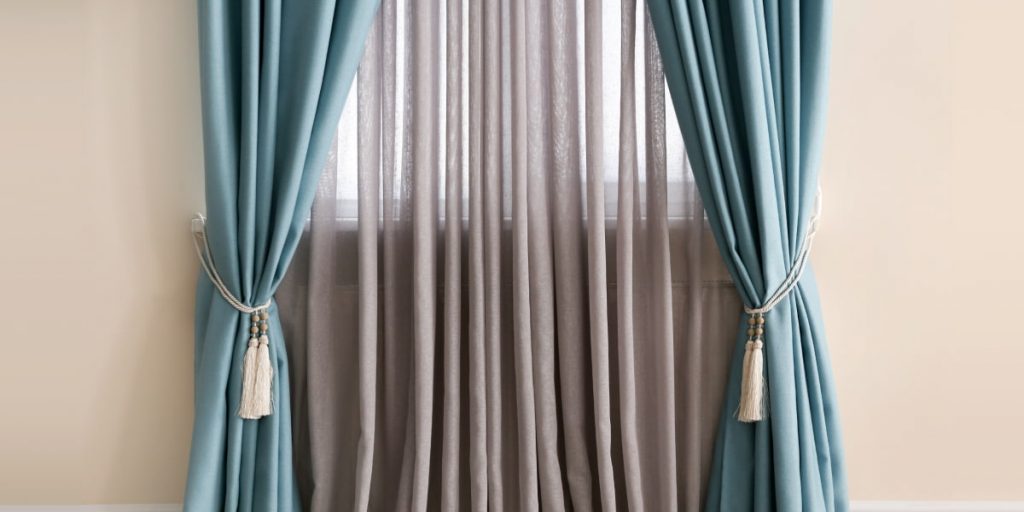
Once you have the thought in your head that it’s time to buy new curtains for your window, you may have a million questions. Do you need curtains that will protect you from the sun’s rays? Or is it more important that they fall gracefully and look good with the rest of your decor?
You may think this is unnecessary because curtains are just a piece of fabric you hang on the windows. But different types of curtains serve other purposes. There are many factors to consider when choosing the right window treatments for your home.
Let’s look at the different types to determine which style of curtains will work best for you.
1. Panel Pair Curtains
As the name suggests, paired curtains come in two separate panels. They usually have different widths and are hung on either side of the window. This type has become especially popular in homes with modern designs and large windows.
To close them, you must slide the two panels of the curtains together. Thus, this curtain design is ideal if you want to make a statement with your curtains or enjoy more privacy in your home.
Panel pairs are also a good choice if you want to block out light or insulate your home from the cold.
2. Single Panel Curtain
Single panel curtains are just one curtain hung on a single rod over the window. They are less formal than pairs of panels and are suitable for small windows. You can also use them on oversized windows, but you may have to buy more than one panel to achieve the desired effect.
For your convenience, we recommend this type of window curtain if you have narrow windows (tall or not) so that you can close the window with one blind without much effort. With a wide window, it would be more functional to have Panel pair curtains.
3. Window Treatment Sets
As the name implies, window treatment sets include two or more elements to cover a window. Typically, a set contains valances, tie-downs, and curtains. It is an excellent option to update your window completely because it brings everything together.
But we must warn you that depending on the design, drapery can be used in different rooms. For example, short ones are better for the kitchen, while luxurious and long ones will look great in the living room.
4. Valances
These curtains are an excellent choice to add elegance to your windows. Valances are a type of curtains that are hung on a rod above a window. They cover the upper part of the window and can be used alone or in combination with other types of curtains.
But this window curtain type also emphasizes the beauty of small windows. And it closes the direct rays of the light which go through the top of the window.
5. Window Tiers
Window tiers are a type of curtain hung on a rod below the window. They cover the lower part of the window and can be used alone or in combination with other types of curtains. Tiers are an excellent choice to add privacy to your windows.
6. Window Scarf
Window scarves are one of the most popular types of window treatments. They are long pieces of fabric you can drape over the entire rod or hang down in the middle.
They come in different colors and patterns to match any decor. You can find them in solid colors, plaids, stripes, and floral designs.
7. Curtain Liners
Curtains also tend to get dusty and need to be washed frequently. But there is an easy way to extend the life of your curtains and make them look new again – by using curtain liners.
Curtain liners are made of different materials, including cotton, polyester, and vinyl. They are placed behind the curtain fabric and help protect it from dust, dirt, and stains. They also add insulation to your windows and help keep out drafts.
Buyers’ Guide: Opaqueness
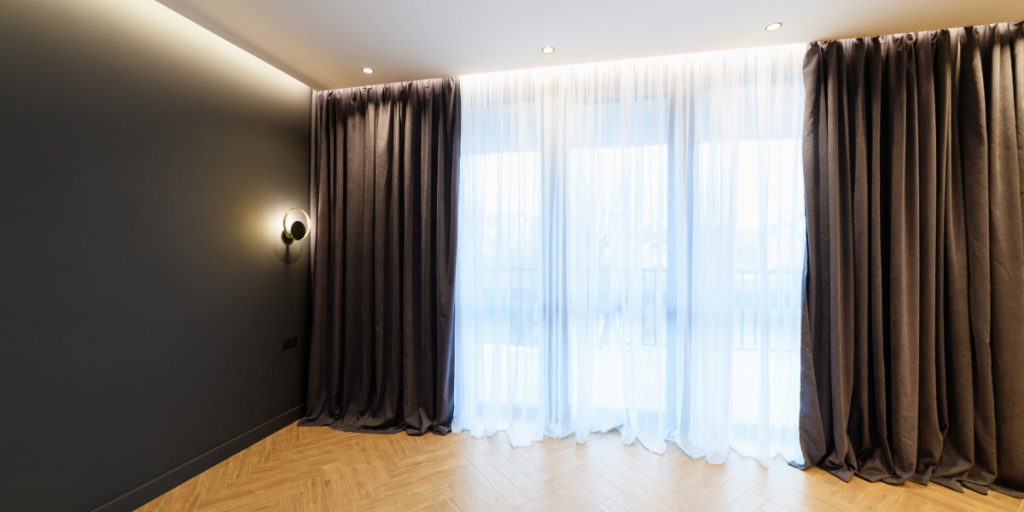
Another vital factor to consider when choosing curtains is the degree of opacity. Curtains with different light-tightness are suitable for various rooms and applications. For example, if you want to achieve complete darkness in a room, you should choose curtains with a high degree of opacity. To determine which window curtain designs you need, ask yourself a few questions:
- Do you want to block out all the light or just some of it?
- How much privacy do you need?
- Do you want your curtains to have additional functions beyond decorative?
Once you have answered these questions, you can narrow down your choices and find the perfect curtains for your home:
1. Sheer Curtains
Curtains are delicate designs of curtains that are made of thin transparent fabric. They let in some light and provide some light privacy but still allow you to see the street and everything going on.
It is ideal if you want a lot of light in the house. But for the bedroom, for example, you may need thick curtains. Curtains are usually chosen for kitchens or living rooms.
2. Semi-Opaque Curtains
Semi-opaque curtains are made of a thicker fabric than transparent curtains. Their main difference is that they provide more privacy. Yes, they let in light, and you can see what’s going on outside the window too, but not as clearly as sheer curtains.
If you want to achieve a balance between privacy and light, choose semi-opaque curtains.
3. Blackout Curtains
Blackout curtains are made of dense opaque fabric. They block out all light and provide complete privacy. They are an excellent choice for bedrooms, nurseries, home theaters, and other rooms where you want to achieve total darkness. You can find different types of blackout curtains in different colors and designs.
Buyers’ Guide: Drapery Attachment Types

So, once you’ve decided on the type of curtains (transparent or not), it is time to move on to the mounts. Curtains have different attachment systems, and depending on what style you go out to achieve, certain styles of curtain mounting will suit you better.
We want to introduce different curtain attachment types to help you choose the right window treatments for your home. But remember, it is not only about function but also about form! Let’s start, we have 4 variants for you:
1. Rod Pocket Curtains
Curtains with pockets are the most common type of curtain attachment. They are easy to install on the rod, and you can do it yourself. Curtains with this system have a pocket on the back that can be slid over the rod.
The main disadvantage of such curtains is that they cannot be moved up or down and do not provide a very tight fit. But if you plan to move the curtains infrequently, this is not a problem.
But a huge plus of such window curtain designs is that they completely cover the ledge, which becomes invisible from the side of the curtains. So it is not only convenient but also beautiful in terms of aesthetics.
2. Grommet and Eyelet Curtains
Grommets and eyelets are different types of window curtains attached to the rod with metal rings. This attachment is more decorative and gives the curtains a more elegant look. Curtains with cornices have large eyelets, and curtains with eyelets have small eyelets.
These window curtain types are easy to move, so they are often hung in places where curtains are frequently opened and closed. In addition, you should understand that this type of attachment is only done on dense curtains.
Curtains with slits and eyelets are also easy to install, but they provide a tighter fit than curtains with pockets.
3. Tab Top
Tab-Top curtains are another type of curtain attachment. They have loops or tongues on the back that can be thrown over the rod. Tied curtains provide a snug fit and are easy to install.
The only drawback is that they are unsuitable for heavy curtains, as the tongues can tear the fabric. Choosing lighter materials, for example, cotton or linen, is better.
4. Hidden Tab Curtains
Hidden Tab Curtains are a variation of tab-top curtains. They have loops on the back, but they are hidden behind a strip of fabric. It gives the curtains a neater look. They are often hung in the living room or bedroom for a fabulous look.
What else sets this type of curtain apart from the Tab-Top is the price. Because more time is spent on this type of work, it can cost a percentage more. So choose what is more important to you in terms of price or a neater look.
Like tab-top curtains, hidden-top curtains provide a snug fit and are easy to install.
Buyers’ Guide: Potential Materials
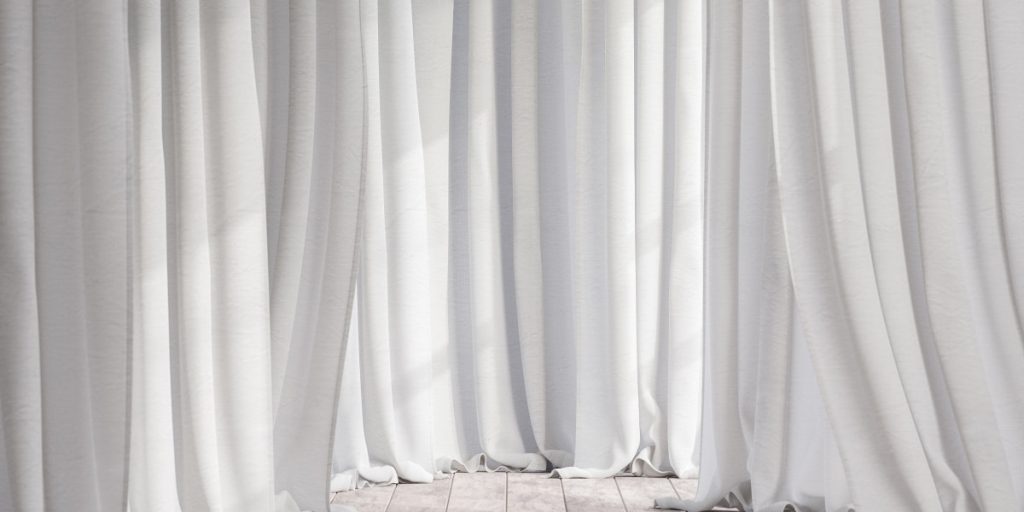
Now moving on to the most enjoyable – the choice of material from which you will make your future curtains. Many people do not care what material will be used in the curtains. But this isn’t very smart because the fabric will perform the primary function in the curtains.
Firstly, the material creates a beautiful image. That is, you choose the design fabric that you like. Secondly, the fabric will directly serve a particular function. For example, it will be translucent curtains or completely block the penetration of sunlight into the room.
We have prepared a list of types of window curtain materials to understand precisely what you need for your decor. And remember, first, decide what kind of material you want, and only then look at the colors and designs of these materials.
1. Cotton
Cotton is a natural fabric that breathes. It is perfect for any time of year and has many different textures. You can make different curtain designs from other kinds of cotton – from light to dense, from thin to thick. This fabric is easy to wash and does not wrinkle. Well, and its price is pleasantly surprising.
2. Linen
Linen is also a natural fabric. It is made from linen, so the material is solid and durable. In addition, linen curtains are easy to wash. The only disadvantages of this fabric are that it can be a little more expensive than cotton and wrinkles.
3. Velvet
Velvet is a luxurious fabric that looks very elegant. It is perfect for the living room or bedroom. But velvet curtains are not suitable for the kitchen because they are challenging to wash. In addition, the price of such a fabric is relatively high.
4. Silk
Silk is a royal fabric for creating different luxurious types of curtains. Curtains with this fabric look very beautiful in any room; whatever design you choose is always beautiful.
5. Burlap
It is a coarse fabric made from natural fibers such as jute or hemp. Even though this material is not very beautiful, it performs its function perfectly – it completely blocks the sunlight. Curtains of burlap are ideal for bedrooms or home offices where you want to create complete darkness.
6. Synthetic
Synthetic fabrics are made from synthetic materials such as polyester, nylon, or acrylic. Although many people don’t like synthetics, curtains with them look lovely. In addition, they are not expensive, do not crease, and are easy to wash.
Buyers’ Guide: What Length of Curtains to Choose?
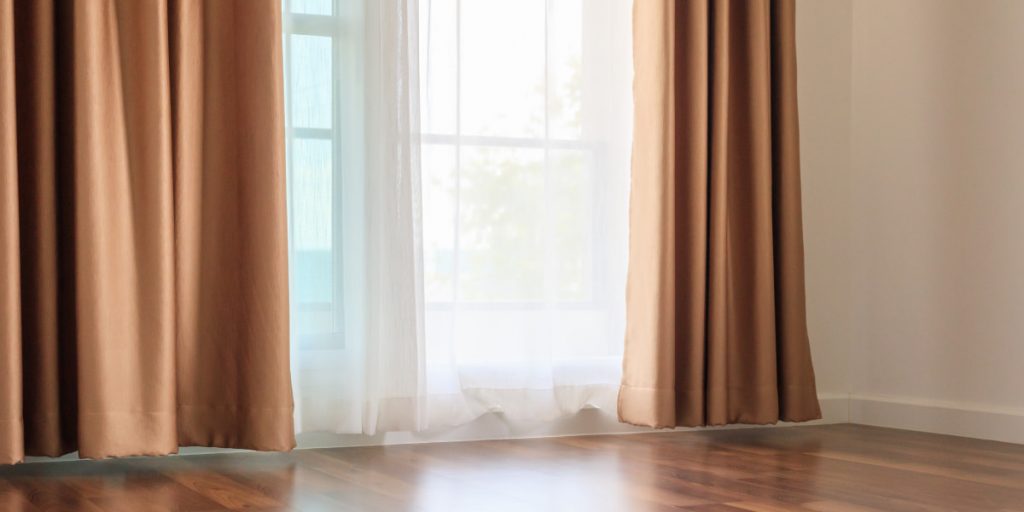
The length of the curtains should be in harmony with the room’s design and the window. If you want to create an elegant look, choose long curtains that touch the floor. It is essential to know that different types of curtains will look different at different lengths.
For example, long transparent curtains create a romantic atmosphere, while short ones look more audacious and modern. So think about what mood you want to create in the room.
We prepared a little guide if you are still determining the different types of curtain lengths to choose from. As you read, you will know precisely what curtains you need.
1. Sill
They are the shortest curtains and usually have a length of about 30-40 cm. Such curtains are installed right on the windowsill, called sill-length curtains. Sill-length curtains look good in any room because they do not hide anything and, at the same time, create coziness.
2. Apron
These curtains are a little longer than sill-length ones. Their length is 50-60 cm. Apron curtains look good in different rooms. The main thing is to choose the right design and fabric for the particular room where you want to hang these curtains.
3. Floor
These window curtain types are the longest, and their length is about 1-2 cm from the floor. Floor-length curtains look good in different rooms, but they are perfect for the living room or bedroom because they create a feeling of comfort and luxury.
4. Puddle
Puddle curtains are floor-length with an additional 10-20 cm long train. Such curtains look beautiful and elegant, but they are not suitable for small rooms because they make the space even smaller.
Buyers’ Guide: Curtain Features
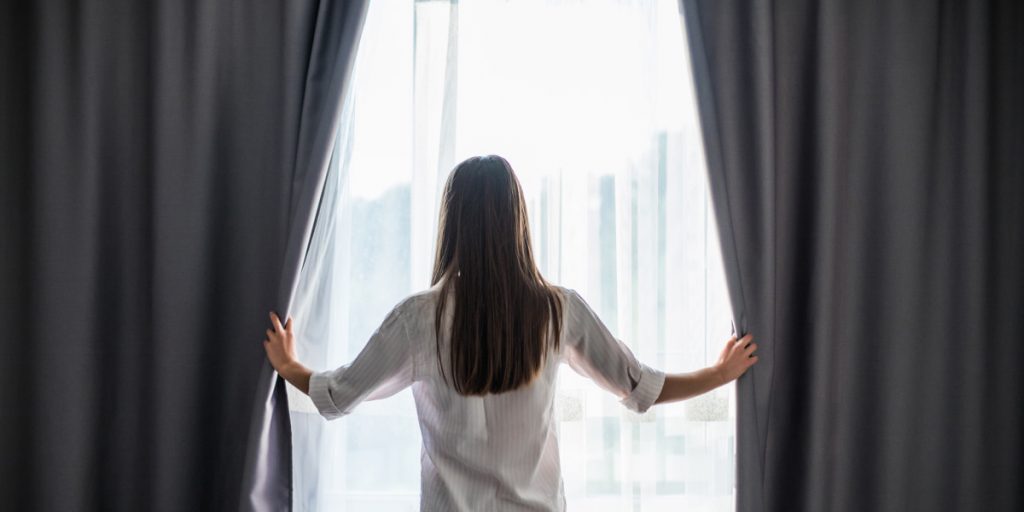
According to the styles of curtain material, they may have additional properties that add a level of functionality:
- Insulating
These curtains are made of materials that have excellent insulating properties. They do not allow heat to pass through, so they are perfect for winter.
- Noise Reducing
Curtains, made of unique materials, can significantly reduce the noise level in the room. If you live near a busy street or have noisy neighbors, such curtains will help create a more comfortable atmosphere at home.
- Outdoor Curtains
Waterproof or water-resistant materials are used to make outdoor curtains. They shield you from the sun, wind, and rain and may be hung on the balcony, patio, or loggia.
Knowing all the various curtain types allows you to select the ideal setting for your house. Just keep in mind to consider the fabric, length, and style to produce harmonious curtains that fit your home flawlessly!
FAQ
Are curtains important in the home?
Curtains are one of the essential home furnishing items. They protect your home from dust, dirt, and unwanted light. Curtains also play a vital role in enhancing the beauty of your home.
Should I choose curtains by function or by decor?
It is essential to consider both function and decor when choosing curtains. If you want curtains for decoration, choose those made of sheer fabric in different colors and patterns. However, if you need curtains for privacy or light control, choose opaque curtains made of thick material.
Can I use different types of curtains in one room?
Yes, you can use different types of curtains in one room. For example, you can use sheers for decoration and thicker curtains for privacy or light control. You can also use different colors and patterns to create a unique look.


